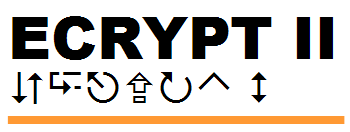 VAMPIRE |
eBACS: ECRYPT Benchmarking of Cryptographic Systems |
 ECRYPT II |
|---|
| General information: | Introduction | eBASH | eBASC | eBAEAD | eBATS | SUPERCOP | XBX | Computers | Arch |
|---|
| How to submit new software: | Tips | hash | stream | aead | dh | kem | encrypt | sign |
|---|
| List of primitives measured: | lwc | sha3 | hash | stream | lwc | caesar | aead | dh | kem | encrypt | sign |
|---|
| Measurements: | lwc | sha3 | hash | stream | lwc | caesar | aead | dh | kem | encrypt | sign |
|---|
| List of subroutines: | verify | decode | encode | sort | core | hashblocks | xof | scalarmult |
|---|
Call for key-encapsulation software for benchmarking
Are you a designer or implementor of a key-encapsulation mechanism? Would you like your software professionally benchmarked on many computers, producing stable, reliable, verifiable timings that reflect the performance that key-encapsulation users will see? This page explains how to submit your software to the eBATS project. Formal submission requirements have been kept to a minimum, but your software needs to follow a few naming conventions so that it can be benchmarked by SUPERCOP.There is a separate page listing the key-encapsulation mechanisms submitted so far, and another page reporting measurements of those functions. Note that the eBATS project also includes public-key signature systems, Diffie–Hellman systems, and encryption systems.
Example for designers: submitting the pqRSA-15 system
Let's say you're the designer of pqRSA-15, a key-encapsulation mechanism with a 786432-bit private key, a 262144-bit public key, a 262144-bit key-encapsulation mechanism, and a 256-bit session key, and you want to submit your pqRSA-15 software to eBATS. Your submission can be as simple as two files, crypto_kem/pqrsa15/ref/api.h and crypto_kem/pqrsa15/ref/kem.c. Here is an explanation of what these files contain and what additional options you have.The top-level directory name crypto_kem is required; it distinguishes key-encapsulation mechanisms from other operations benchmarked by SUPERCOP, such as crypto_hash and crypto_sign.
The second-level directory name pqrsa15 should be a lowercase version of your system's name. Please omit dashes, dots, slashes, and other punctuation marks; the directory name should consist solely of digits (0123456789) and lowercase ASCII letters (abcdefghijklmnopqrstuvwxyz).
Different key-encapsulation mechanisms must be placed into different second-level directories, even if they are part of the same "family" of functions. For example, crypto_kem/pqrsa20 is separate from crypto_kem/pqrsa15. One submission tarball can include several key-encapsulation mechanisms in separate directories. Directory names may be changed by the eBATS managers to resolve conflicts or confusion.
The third-level directory name ref is up to you. Different implementations must be placed into different third-level directories. You can use subdirectories here; for example, crypto_kem/pqrsa15/ref might be a reference implementation, crypto_kem/pqrsa15/smith/little might be John Smith's little-endian implementation, and crypto_kem/pqrsa15/smith/neon might be John Smith's NEON-optimized implementation. One submission tarball can include several implementations.
After choosing the implementation name crypto_kem/pqrsa15/ref, create a directory by that name. Inside the crypto_kem/pqrsa15/ref directory, create a file named api.h with four lines
#define CRYPTO_SECRETKEYBYTES 98304
#define CRYPTO_PUBLICKEYBYTES 32768
#define CRYPTO_CIPHERTEXTBYTES 32768
#define CRYPTO_BYTES 32
indicating that your software uses
a 98304-byte (786432-bit) secret key,
a 32768-byte (262144-bit) public key,
a 32768-byte (262144-bit) ciphertext,
and a 32-byte (256-bit) session key.
Next, inside the crypto_kem/pqrsa15/ref directory, create a file named kem.c that defines the following functions:
#include "crypto_kem.h"
int crypto_kem_keypair(
unsigned char *pk,
unsigned char *sk
)
{
...
... the code for your pqRSA-15 implementation goes here,
... generating public key pk[0],pk[1],...
... and secret key sk[0],sk[1],...
...
return 0;
}
int crypto_kem_enc(
unsigned char *c,
unsigned char *k,
const unsigned char *pk
)
{
...
... the code for your pqRSA-15 implementation goes here,
... generating session key k[0],k[1],...
... and ciphertext c[0],c[1],...
... from public key pk[0],pk[1],...
...
return 0;
}
int crypto_kem_dec(
unsigned char *k,
const unsigned char *c,
const unsigned char *sk
)
{
...
... the code for your pqRSA-15 implementation goes here,
... generating session key k[0],k[1],...
... from ciphertext c[0],c[1],...
... and secret key sk[0],sk[1],...
...
return 0;
}
Your functions must have exactly the prototypes shown here.
The keypair function must have
an unsigned char pointer for the public-key output
and an unsigned char pointer for the secret-key output.
The enc function must have
an unsigned char pointer for the ciphertext output,
an unsigned char pointer for the session-key output,
and a const unsigned char pointer for the public-key input.
The dec function must have
an unsigned char pointer for the session-key output,
a const unsigned char pointer for the ciphertext input,
and a const unsigned char pointer for the secret-key input.
Your functions must return 0 to indicate success,
or a negative number to indicate failure (e.g., out of memory).
You can use names other than kem.c. You can split your code across several files *.c defining various auxiliary functions; the files will be automatically compiled together. You must include crypto_kem.h for any file referring to the crypto_kem_* functions. The file crypto_kem.h is not something for you to write or submit; it is created automatically by SUPERCOP. See the SUPERCOP tips for more advice and options.
Finally, create a tarball such as pqrsa15-ref-3.01a.tar.gz that contains your crypto_kem/pqrsa15/ref/api.h, crypto_kem/pqrsa15/ref/kem.c, etc. Put the tarball on the web, and send the URL to the eBACS/eBATS/eBASC/eBASH mailing list with a note requesting inclusion in SUPERCOP and subsequent benchmarking.